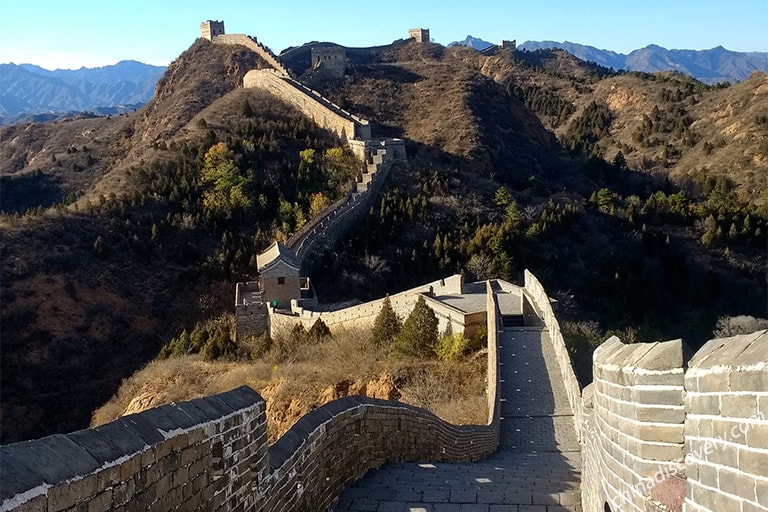Weichang Bashang can be divided into Saihanba National Forest Park, Yudaokou Plain and Forest Resort, Wulanbu Series Prairie and Huamugou Forest Farm. As the heaven of photographers, almost every place is good place for shooting. The most beautiful and suitable sites for photography are as the follows.
Best Sites for Photography
Three Mountains around Weichang
The three mountains are Big Red Hill, Little Red Hill and Lama Hill. These three mountains are not far from one another and they are located near from the Red Hill Military Horse Farm. They are recommended as the sunrise shooting places by the local people. Relatively speaking, Little Red Hill has the best view to shoot, and car can drive to the top of the hill. Besides, there is a village at the foot of Little Red Hill, and in autumn, there will be a large temperature difference between day and night, so this is also a good place to shoot kitchen smoke.
Wucai Hill
Wucai Hill (Wucai means five colors in Chinese) is 20km west to Red Hill Military Horse Farm. Once the autumn comes, due to the frost action, the trees will show different colors. At this time, Wucai Hill is just like dressing festival clothes and this will be a feast to your eyes.

Beigou
Beigou is a north-south ditch and is north to Red Hill Military Horse Farm. The length of Beigou is over 10km and most of Beigou is claimed by secondary forest. There are overgrown with birches at the hillside, while the bottom of the ditch is covered by wild hawthorns, pagoda trees and elms. Beigou is the rotational grazing area permitted by the Horse Farm. So you can see the herds of cows and sheep in here. Best time to shoot is morning and dusk.
Hamaba
As a classic shooting site, Hamaba is about 50km to Red Hill Military Farm. Hamaba is a gentle slope and it is located at a hilly and mountainous region. This site is suitable for shooting all year around. While the autumn of Hamaba is extremely beautiful for it’s very colorful in autumn. Village, herds of animals and forests are all your subjects to shoot. If the weather is fine, you can shoot the effect of light and shade just before sunrise or sunset against the sunlight, and you can also shoot the scene with bluish color after the sunset.
Gongzhu Lake
This is a little lake surrounded by birch forests and other trees. Across the lake is a white sand beach. The trees reflection on the lake surface under the sunlight forms a natural landscape painting. Though Gongzhu Lake is not big, it has its unique charms. Sunrise time and sunset time are all good time to shoot in Gongzhu Lake.

Panlong Valley
About 20km from Red Hill Military Horse Farm and 4km from Gongzhu Lake, Panlong Valley is a quiet place consisted of grassland, primitive forest, lake and valley. Developed at 1994, Panlong Valley still reserve its original features till today. In autumn, when the trees are bare in other places, Panlong Valley still has a good view because it’s low-lying position.
Best Season for Photography
For normal tourists, the best season to travel to Bashang is summer and autumn (from June to October). July to August is the golden time to avoid summer heat. However, for shutterbugs, you can shoot good pictures all year round.
The spring on Bashang starts from the mid May. At this time, the verdant grassland is covered by a carpet of flowers. All kinds of flowers bloom one by one. The color of the grassland will rotate among Yellow, red, white, blue and violet every half month till the end of summer.
When the summer (July to August) comes, the sky is high, the land is broad, the fields are green, the air is clear and the climate is cool. Look up from a high land, you will feel as if the sky and cloud is reachable. Look down at the open field, the grass and flowers swing with summer breeze, and horses gallop on the vast field.
As for the golden autumn, from mid-September to the end of September, the land keeps changing its coat color from dark green to golden yellow, and then to fire red. In the half agriculture and half pastoral area, straight paths cross the fields and divide the fields into different-color zones, as if nature draw us a bright and colorful oil painting.
During the winter time, the world is cladded in silvery white. Ink-colored thicket spread on the silvery white field, sporadic horses wandering around, a plume of smoke comes out of the snow-covered thatched house. All these forms a natural Chinese ink painting.
Tips from Our Experts
1. Recommended equipment
Shoot on the grassland, telephoto lens, wide angle lens and tripod are recommended. While when you shoot the winter Bashang, polarizer is useful to filter the reflection of the snow land.
2. Living equipment
Large temperature difference between day and night, so bring warm clothes is very important. Especially in autumn and winter, the temperature at night is normally is below zero, so down jacket is recommended. Even in summer, you’d better wear long trousers to avoid the mosquito bite and weed scratch. Sunblock can protect you from sun burns.
3. How to choose interesting objects
Sheep, horses, cars and even geirs can bring more vitality and fun to your photo. Normally, these objects are arranged around the golden section points to be coordinated with the picture.
4. How to arrange the position of horizon line
The positions of horizon line and sky are very important. According to different scenes, there are three ways to arrange horizon line. First, put the horizon line in the upper one-third position can highlight the vast of the grassland. Second, place the horizon line in the center is suitable for lake photography. While the horizon line in the lower one-third position can highlight the cloud and sunglow in the sky.
5. Transportation advice
From Beijing to Weichang Bashang, the most convenient way is by bus. The drive will take about 5 hours.
6. Accommodation advice
Vocational villages and hotels are mainly located at Jixie Forest Farm and Red Hill Military Horse Farm. It’s better to book the hotel in advance of two weeks in July and August, or else you may have to stay overnight at home-style hotels with poor housing conditions.































































